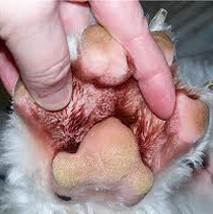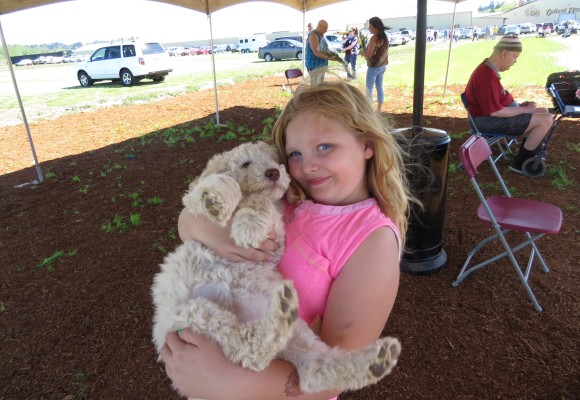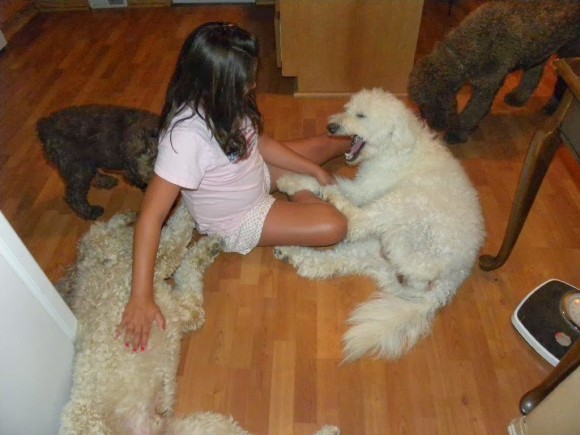



Me at Petsmart picking out dog food
Once you have selected a good quality dog food, that’s all you need to feed, right?
Not really.
“There is no one “perfect†food or perfect food combination that provides everything a human or animal needs to create optimum health over long periods.
Rotating protein sources not only ensures your pet will benefit from a varied amino acid and nutrient profile, it also reduces the risk he will form an intolerance to any specific animal protein source over time.”
– W. Jean Dodds, DVM
The Rotation Diet is really all about variety. It’s a holistic and nutritional philosophy that offers your pet a dietary alternative — varying both food proteins (chicken, beef, lamb, fish even kangaroo etc.) and food forms (raw, frozen, wet, dry, etc.). This way your dog or cat is able to enjoy and experience different flavors and textures.
There are many good reasons for a rotation diet:
Dogs (actually all mammals) are designed to consume a range of different foods, and to obtain differing vitamins and minerals from each. They are not designed to eat “only chicken†or “only lamb†or any other food item for eternity. Changing foods, importantly the contents of those foods, every so often helps to give them the variety their bodies were designed to thrive on.
There is no one dog food in existence that “has it allâ€. And remember, the feeding trials that foods go through only last for six months (and not all foods are even trialed). Changing foods periodically helps to ensure that no dietary deficiencies or excesses build up over time.
Variety is the spice of life. Who wants to eat the same food day in and day out? Could you? For months or years?
Feeding your dog something different helps ensure they don’t become bored and frustrated with their food.
This will not make your dog picky – we’re talking about periodic changes, not serving something different or adding new goodies to tempt him every time he doesn’t like his dinner.
This also helps to avoid the development of allergies. In a few extreme cases, you (or your dog) may be instantly and violently allergic to something. But that’s only in a few extreme cases – the vast majority of allergies build up over time and with constant exposure.
The surest way to develop an allergy to chicken, for example, is to consume it daily for an extended period. It is no coincidence that the most common allergens for dogs are also the ingrediant most commonly used in dog foods for years.
The (modern) advice given by canine nutritionists is to feed a wide variety of different foods, preferably starting at a young age. This can help you to avoid the development of allergies in the first place (this is the same advice given to humans as well).
Dogs with a food allergy!
 Common signs of allergies are itchy skin, red itchy paws, chewing paws, yeast infections, chronic ear infections, and skin infections that may respond to antibiotics but reappear as soon as the antibiotics are discontinued.
Common signs of allergies are itchy skin, red itchy paws, chewing paws, yeast infections, chronic ear infections, and skin infections that may respond to antibiotics but reappear as soon as the antibiotics are discontinued.
That all adds up to changing the food you feed every once in a while. That means changing to a food with different main ingredients and protein.
There’s very little benefit to switching from one chicken/rice food to another, for example. If you’ve been feeding a food with chicken as the main ingredient, it’s far better when the next food is lamb, turkey, fish, or beef based and that the other main ingredients are also varied.
Dog food ingredients most likely to provoke an allergic reaction include…
If you’re concerned that your dog might harbor a food sensitivity try the elimination diet. Understanding Canine Allergies
No, not necessarily. Look at the ingredients in the different formulas made by your dogs favorite brand. What’s different? If it’s only the main meat ingredient, then you should try changing to a different brand when you change foods.
If many of the ingredients, including the main meat/protien, are different then there’s no need to change brands.
The point is to ensure your dogs getting a wide variety of different foods in his diet. Not brand loyalty.
It’s not necessary to change your dog’s food on a weekly or even monthly basis. It’s recommended to rotate your dog’s food every three months.
When transitioning your dog or puppy to a new food, transition them slowly over the course of a week. With each meal, feeding them an increasing amount of the new food, and decreasing amount of the previous food, until you’ve completely switched them to the new food.
If your dog doesn’t suffer from digestive upsets when his food is changed, then you might even consider changing foods every time the bag runs out. (If your dog has GI Disease or problems then diet changes should be discussed and monitored with the guidence of a Vet.)
At least three or four different foods (different main meat source and different main ingredients). More is better. You can certainly reuse a good food, especially if your dog does particularly well on it.
You could choose, for example, to feed Food #1 for one bag then change to Food #2 – go back to Food #1 and then to Food #3 and so on. This satisfies the criteria of avoiding constant or prolonged exposure to a particular set of ingredients.
Mixing foods together can certainly help to ensure nutritional adequacy for the long term. But it does nothing to provide your dog with variety (something different to eat!) and it does not satisfy the criteria of avoiding constant or prolonged exposure to a particular set of ingredients. So this practice will do nothing to help avoid the development of food allergies – it just means that there are a greater number of things the dog is being exposed to on a constant basis. It also means that there is a wider range of possible culprits should a food allergy develop. You can mix foods if you choose, but you should vary the foods that you mix together, just as if you were feeding a single food.
It’s much easier to start rotation feeding while he or she is still a puppy or kitten (assuming they are already eating solid food), but that’s not to say an older dog or cat can’t benefit from rotation feeding too. It just may take a little bit more patience.
To minimize the risk that your dog will have a bad reaction to the rapid diet change, there are some important steps you must take.

When switching dog food you should do it gradually, mix in small amounts of the new brand with the old brand.
Probiotic supplements can also reduce the chance that your dog will develop diarrhea when its diet suddenly changes. (Yogurt on top of the new food can help)
Here is the transition process to use when changing your dog’s food:
Always switch gradually and if you’re forced to switch to a new brand rapidly because you’re old brand is no longer available then transition them with a chicken/rice mixture instead of the old food over a longer period of time. keep an eye on them and if at any time your dog does develop diarrhea, take them off all food entirely for 12 hours to allow the stomach to calm down and then feed them small meals of boiled white rice and boiled white chicken meat for a few days.
For the surprising answer to more questions about dog food rotation diets and dog food allergies, be sure to watch this video by Dr. Karen Becker and visit the resources below!
For more information on Food Rotation Diets:
